How The Role Of Physicians Has Changed Over Time In America
While the Civil war propelled the progress of American medicine much faster than what would have probably transpired without information technology, our staunch belief in capitalism has prevented u.s. from developing the kind of national healthcare the United Kingdom , French republic, and Canada have used for decades. Every bit a effect, we take our own unique system that has evolved drastically over the past century into something that is both loved and hated by its citizens. Whichever end of the spectrum yous lean toward, there's no doubt nearly information technology: the history of medicine and organized healthcare in America is a long and winding road. How we've gotten to where we are today is quite a story, then let'southward dive in... Medicine was fairly rudimentary for the first few generations of colonists who landed in the new world, primarily because very few upper-course physicians emigrated to the colonies. Women played a major part in administering care in these early days, about especially when it came to childbirth. Mortality in those early on days was extremely high, nearly notably for infants and small children. Malaria was particularly brutal, as was diphtheria and yellow fever. Near of the ill were treated with folk remedies, though smallpox inoculation was introduced earn-on (long earlier it was embraced in Europe.) In these early days, in that location was nearly no regime regulation or attention paid to public health. In 1765, the Medical College of Philadelphia was founded. Ii years later, the medical department of King'south College was established in New York and in 1770, they awarded the start American M.D. degree. As was mutual in the twenty-four hours, more soldiers died of affliction than from fighting in the Civil State of war. The conditions in the Confederacy were particularly brutal, due to astringent shortages of medical supplies and physicians. Lack of hygiene and cramped quarters brought about epidemics of childhood diseases like measles, mumps, chickenpox, and whooping cough. Diarrhea, dysentery, and typhoid fever ravaged the south, in particular. The state of war did usher in a wave of progress in the form of surgical techniques, research, nursing methods, and care facilities. The Union built army hospitals in every state, and proactive medical organizers achieved considerable progress cheers to a well-funded United States Army Medical Department and the Usa Sanitary Committee. Numerous other new health-related agencies were as well formed during this time, raising public consciousness about healthcare. In addition to the Federal government, states also started pouring money into healthcare. Following the particularly bloody battle of Shiloh in April of 1862, the state of Ohio sent boats to the scene, which they converted into floating hospitals. Similar deportment in other states soon followed. Later on the state of war ended, in 1886, the U.S. Army established the Hospital Corps. Significant amounts of statistical data were collected during the state of war, necessitating methods to access and search this treasure trove of information for pattern recognition. John Shaw Billings, who served as a senior surgeon during the war, congenital the Library of the Surgeon Full general's Office, which became the hub of our modern medical information systems. Though founded in 1849, the American Medical Association (AMA) started to gain momentum towards the end of the century, and by 1899 information technology grew its membership to capture most half the physicians in the land. Most healthcare up to this point in time was provided equally a "fee-for-service", with payment due at the time of care. Some private insurance pools and employer-provided healthcare exists, but not much. As President at the plow of the century, Theodore Roosevelt (1901-1909), believed health insurance was of import because "no country could be strong whose people were sick and poor." Even so, he didn't lead the charge for stronger healthcare in America. In fact, most of the initiatives in the early 1900'southward were led by organizations outside the government. Every bit the industrial revolution continued to whorl-on, the dangerous nature of the work led to more than and more workplace injuries. As these manufacturing jobs (much of them involving strenuous activities and heavy machinery) became increasingly more prevalent, unions grew stronger . To shield union members from catastrophic financial losses due to injury or illness, companies began to offering various forms of sickness protection. Ane of the organizations heavily involved with advancing healthcare for American workers was the American Clan of Labor Legislation (AALL), who drafted legislation targeting the working course and low-income citizens (including children). Under their proposed pecker, qualified recipients would receive sick pay, motherhood benefits, and a decease benefit of $50.00 to encompass funeral expenses. The cost of these benefits would be split between states, employers, and employees. The AMA initially supported the nib, just some medical societies expressed objections, citing concerns over how doctors would be compensated. The fierce opposition acquired the AMA to back down and ultimately pull support for the AALL nib. Union leaders also feared that compulsory wellness insurance would weaken their value, as a portion of their power came from being able to negotiate insurance benefits for union members. The private insurance industry also opposed the AALL Bill because they feared it would undermine their business. If Americans received compulsory insurance through the regime, they might not see the demand to buy additional insurance policies privately, which could put them out of business organisation — or at the very least, cut into their profits. In the cease, the AALL neb couldn't garner enough support to move forward. Around the same time the AALL was pushing for worker protections, the Progressive Political party was championing the idea of a National Wellness Service and public healthcare for the elderly, disabled, and unemployed. Hither too, the AMA and other organizations put up strong opposition to the plan, and the American working class also wasn't supportive of the idea of compulsory healthcare. In 1916, the Progressive Party dissolved, thereby ensuring that the U.S. wouldn't experience the groundswell of public support for public healthcare that leading European nations would experience before long after. After the start of Earth State of war I, Congress passed the War Run a risk Insurance Act, which covered military servicemen in the event of death or injury. The Human activity was later amended to extend financial support to the servicemen'south dependents. The State of war Risk Insurance program essentially ended with the conclusion of the state of war in 1918, though benefits continued to exist paid to survivors and their families. Later on the war, the cost of healthcare became a more pressing matter, as hospitals and physicians began to charge more than the average denizen could beget. In 1923, Baylor Hospitals in Dallas created a unique program, in conjunction with local schools, to provide healthcare to teachers for a pre-paid monthly fee. The programme quickly defenseless on, expanding to schools across the nation, thereby giving nascency to the nonprofit Bluish Cantankerous/Blue Shield. Private insurers took notice, inspiring a host of them to enter the market. When the Great Low hit in the '30s, healthcare became a more heated argue, almost especially for the unemployed and elderly. Fifty-fifty though "The Blues" (Bluish Cross and Blue Shield) were expanding across the country, the 32nd President of the U.s., Franklin Delano Roosevelt (1933-1945), knew healthcare would grow to exist a substantial problem, so he got to work on a health insurance bill that included the "old age" benefits desperately needed at the time. All the same, the AMA once once more fiercely opposed any plan for a national health arrangement, causing FDR to drop the health insurance portion of the pecker. The resulting Social Security Human action of 1935 created the first existent system of its kind to provide public support for the retired and elderly. Information technology besides allowed states to develop provisions for people who were either unemployed or disabled (or both). Around this time, Henry Kaiser, a leading industrialist of the day, contracted with Dr. Sidney Garfield to provide pre-paid healthcare to vi,500 of his employees working in a rather remote region on the largest construction site in history - the K Canyon Dam. (Dr. Garfield had recently set-up a similar arrangement to provide intendance to thousands of men working on the Colorado River Channel Project.) The plan was a large hit with Kaiser's workers and their families, but as the dam neared completion in 1941, information technology seemed equally if the program would fade away. As the U.S. entered World War II after the assault on Pearl Harbor, attention fell from the publicly-provided health insurance debate. Substantially all government focus was placed on the war attempt, including the Stabilization Act of 1942, which was written to fight inflation past limiting wage increases. Since U.Due south. businesses were prohibited from offering higher salaries, they began looking for other means to recruit new employees too as incentivizing existing ones to stay. Their solution was the foundation of employer-sponsored health insurance as we know it today. Employees enjoyed this benefit, as they didn't have to pay taxes on their new grade of compensation, and they were able to secure healthcare for themselves and their families. America's entry into World War 2 likewise brought tens of thousands of workers pouring into the Henry Kaiser Shipyards in California, Washington, and Oregon, to meet the county's demand for warships. Facing the same result he did with his dam project, of providing healthcare to more than 30,000 employees working in adequately remote areas, Kaiser once again contracted with Dr. Garfield (who President Roosevelt has to release from his military machine obligation) to organize and run a pre-paid group exercise for these shipyard workers. This pre-paid arrangement of care would eventually become the Kaiser Permanente Health Plan, which would eventually evolve into our present-day managed care organization of HMOs and PPOs. Later the war ended, the practice of employers providing healthcare connected to spread, as veterans returned habitation and began looking for piece of work in a bustling economy desperate to recruit the best talent. While this was an comeback for many, it left out vulnerable groups of people: retirees, those who are unemployed, those unable to work due to a inability, and those who had an employer that did not offering health insurance. In an effort to not alienate at-risk citizens, some government officials felt it was important to keep pushing for a national healthcare arrangement. The Wagner-Murray-Dingell Bill was introduced in 1943, proposing universal health intendance funded through a payroll tax. If the history of healthcare thus far could be a lesson for anyone, the bill faced intense opposition and eventually was drowned in committee. When FDR died in 1945, Harry Truman (1945-1953) became the 33rd President of the The states. He took over FDR'southward erstwhile national health insurance platform from the mid-'30s, simply with some key changes. Truman's plan included all Americans, rather than only working course and poor citizens who had a hard time affording intendance — and it was met with mixed reactions in Congress. Some members of Congress called the plan "socialist" and suggested that it came straight out of the Soviet Marriage, adding fuel to the Red Scare that was already gripping the nation. In one case once more, the AMA took a hard stance against the neb, also claiming the Truman Assistants was towing "the Moscow party line." The AMA fifty-fifty introduced their own programme, which proposed private insurance options, departing from their previous platform that opposed third-parties in healthcare. Even after Truman was re-elected in 1948, his health insurance program died as public support dropped off, and the Korean War began. Those who could afford it began purchasing health insurance plans privately, and labor unions used employer-sponsored benefits as a bargaining chip during negotiations. As the government became primarily concerned with the Korean War, the national health insurance debate was tabled once again. While the state tried to recover from its tertiary war in twoscore years, medicine was moving forward. It could be argued that the effects of Penicillin in the '40s opened people'due south optics to the benefits of medical advancements and discoveries. In 1952, Jonas Salk's team at the University of Pittsburgh created an effective Polio vaccine , which was tested nationwide two years later and was approved in 1955. During this same fourth dimension frame, the first organ transplant was performed when Dr. Joseph Murray and Dr. David Hume took a kidney from one man and successfully placed it in his twin brother. Of course, with such leaps in medical advocacy, came additional price — a story from the history of healthcare that is withal repeated today. During this decade, the price of hospital intendance doubled , again pointing to America's desperate need for affordable healthcare. But in the meantime, not much changed in the health insurance mural. By 1960, the government started tracking National Health Expenditures (NHE) and calculated them equally a percentage of Gross Domestic Product (Gross domestic product). At the start of the decade, NHE accounted for 5 pct of Gross domestic product. When John F. Kennedy (1961-1963) was sworn in equally the 35th President of the United States, he wasted no time at all on a healthcare plan for senior citizens. Seeing that NHE would continue to increment and knowing that retirees would be most affected, he urged Americans to go involved in the legislative process and pushed Congress to pass his nib. Simply in the stop, it failed miserably against harsh AMA opposition and again — fright of socialized medicine. Later on Kennedy was assassinated on November 22, 1963, Vice President Lyndon B. Johnson (1963-1969) took over every bit the 36th President of the Us. He picked up where Kennedy left off with a senior citizen'south health plan. He proposed an extension and expansion of the Social Security Act of 1935, as well as the Hill-Burton Program (which gave regime grants to medical facilities in need of modernization, in exchange for providing a "reasonable" amount of medical services to those who could not pay). Johnson'due south program focused solely on making sure senior and disabled citizens were all the same able to access affordable healthcare, both through physicians and hospitals. Though Congress made hundreds of amendments to the original bill, information technology did non confront nearly the opposition that preceding legislation had — one could speculate as to the reason for its easier path to success, but it would exist impossible to pinpoint with certainty. Information technology passed the House and Senate with generous margins and went to the President's desk. Johnson signed the Social Security Human activity of 1965 on July 30 of that twelvemonth, with President Harry Truman sitting at the table with him. This bill laid the groundwork for what nosotros now know equally Medicare and Medicaid. By 1970, NHE accounted for half dozen.9 percent of GDP, due in office to "unexpectedly high" Medicare expenses. Considering the U.Southward. had not formalized a health insurance arrangement (information technology was even so merely people who could afford information technology ownership insurance), they didn't really have any idea how much information technology would price to provide healthcare for an entire grouping of people — especially an older group who is more than likely to take health problems. Nevertheless, this was quite a jump in a x year time span, merely it wouldn't exist the last time nosotros'd come across such jumps. This decade would mark another push button for national health insurance — this time from unexpected places. Richard Nixon (1969-1974) was elected the 37th President of the The states in 1968. Every bit a teen, he watched ii brothers die and saw his family struggle through the 1920s to care for them. To earn actress coin for the household, he worked as a janitor. When it came fourth dimension to apply for colleges, he had to plow Harvard downward because his scholarship didn't include room and board. Entering the White House every bit a Republican, many were surprised when he proposed new legislation that strayed from political party lines in the healthcare debate. With Medicare still fresh in everyone'south minds, it wasn't a stretch to believe boosted healthcare reform would come up hot on its heels, and so members of Congress were already working on a programme. In 1971, Senator Edward (Ted) Kennedy proposed a single-payer plan (a modern version of a universal, or compulsory organisation) that would exist funded through taxes. Nixon didn't want the government to achieve so far into Americans' lives, so he proposed his own plan, which required employers to offer health insurance to employees and even provided subsidies to those who had trouble affording the cost. Yous can read more nearly the history of employer-sponsored healthcare by downloading our free guide below. Nixon believed that basing a health insurance system in the open market place was the best fashion to strengthen the existing makeshift organization of private insurers. In theory, this would take allowed the bulk of Americans to have some grade of wellness insurance. People of working age (and their immediate families) would have insurance through their employers, then they'd be on Medicare when they retired. Lawmakers believed the bill satisfied the AMA because doctors' fees and decisions would not be influenced by the authorities. Kennedy and Nixon ended up working together on a program, but in the end, Kennedy buckled under pressure from unions, and he walked abroad from the deal — a decision he subsequently said was "one of the biggest mistakes of his life." Shortly after negotiations bankrupt down, Watergate hit, and all the support Nixon's healthcare plan had garnered completely disappeared. The bill did not survive his resignation, and his successor, Gerald Ford (1974-1977), distanced himself from the scandal. However, Nixon was able to accomplish two healthcare-related tasks. The first was an expansion of Medicare in the Social Security Subpoena of 1972, and the other was the Health Maintenance Organisation Act of 1973 (HMO), which established some society in the healthcare industry chaos. But by the terminate of the decade, American medicine was considered to be in "crunch," aided by an economic recession and heavy inflation. By 1980, NHE accounted for 8.9 per centum of GDP, an even larger jump than the decade prior. Under the Reagan Administration (1981-1989), regulations loosened across the lath, and privatization of healthcare became increasingly mutual. In 1986, Reagan signed the Consolidated Omnibus Budget Reconciliation Act (COBRA), which allowed former employees to continue to be enrolled in their previous employer's grouping wellness plan — as long equally they agreed to pay the full premium (employer portion plus employee contribution). This provided health insurance admission to the recently unemployed who might take otherwise had difficulty purchasing private insurance (due to a pre-existing condition, for example). By 1990, NHE accounted for 12.1 percent of Gdp — the largest increase thus far in the history of healthcare. Like others before him, the 42nd President of the United States, Bill Clinton (1993-2001), saw that this rapid increment in healthcare expenses would be dissentious to the average American and attempted to have activity. Presently after beingness sworn in, Clinton proposed the Health Security Human action of 1993. Information technology proposed many similar ideas to FDR and Nixon'southward plans — a mix of universal coverage while respecting the private insurance system that had formed on its own in the absence of legislation. Individuals could purchase insurance through "state-based cooperatives," companies could not deny anyone based on a pre-existing condition, and employers would be required to offer health insurance to full-fourth dimension employees. Multiple bug stood in the way of the Clinton programme, including strange affairs, the complexity of the bill, an increasing national deficit, and opposition from big business. Afterward a period of debate toward the stop of 1993, Congress left for winter recess with no conclusions or decisions, leading to the bill's repose death. The final healthcare contribution from the Clinton Administration was part of the Balanced Budget Human activity of 1997. It was called the Children'southward Health Insurance Program (Fleck), and it expanded Medicaid assistance to "uninsured children up to age nineteen in families with incomes also high to qualify them for Medicaid." CHIP is run by each individual country and is withal in employ today. In the meantime, employers were trying to detect ways to cut back on healthcare costs. In some cases, this meant offer HMOs , which by pattern, are meant to cost both the insurer and the enrollee less money. Typically this includes cost-saving measures, such as narrow networks and requiring enrollees to see a main care physician (PCP) before a specialist. Generally speaking, insurance companies were trying to proceeds more control over how people received healthcare. This strategy worked overall — the '90s saw slower healthcare toll growth than previous decades. Past the year 2000, NHE accounted for xiii.3 percent of GDP — just a 1.2 percent increase over the past decade. When George W. Bush (2001-2009) was elected the 43rd President of the United States, he wanted to update Medicare to include prescription drug coverage. This thought eventually turned into the Medicare Prescription Drug, Improvement and Modernization Act of 2003 (sometimes called Medicare Part D). Enrollment was (and still is) voluntary, although millions of Americans utilise the program. The history of healthcare slowed down at that point, as the national healthcare debate was tabled while the U.Due south. focused on the increased threat of terrorism and the 2d Iraq War. It wasn't until election campaign mumblings began in 2006 and 2007 that insurance worked its manner back into the national discussion. This menses of time would bring a new, but divisive chapter in the history of healthcare in America. When Barack Obama (2009-2017) was elected the 44th President of the The states in 2008, he wasted no fourth dimension getting to piece of work on healthcare reform. He worked closely with Senator Ted Kennedy to create a new healthcare police that mirrored the one Kennedy and Nixon worked on in the '70s. Like Nixon'south bill, it mandated that applicable big employers provide wellness insurance, in add-on to requiring that all Americans deport health insurance, even if their employer did not offering it. The beak would institute an open Market place, on which insurance companies could not deny coverage based on pre-existing weather. American citizens earning less than 400 percent of the poverty level would authorize for subsidies to help cover the cost. Information technology wasn't universal or single-payer coverage but instead used the existing individual insurance manufacture model to extend coverage to millions of Americans. The bill circulated the House and the Senate for months, going through multiple revisions, but ultimately, passed and moved to the President's desk. On March 23, 2010, President Obama signed the Patient Protection and Affordable Care Act (PPACA), commonly called the Affordable Intendance Act (ACA) or ObamaCare into police. The police force represented the most meaning overhaul and expansion of healthcare coverage since the passage of Medicare and Medicaid back in 1965. Because the law was complex and the first of its kind, the government issued a multi-year rollout of its provisions. In theory, this should accept helped ease insurance companies (and individuals) through the transition, but in practice, things weren't so polish. The kickoff open enrollment season for the Marketplace started in October 2013, and it was rocky, to say the least . Businesses today are dealing with an overwhelming number of legal requirements. We provide a commencement place to plough for extensive and dependable guidance and support for Federal and State compliance issues large and modest.Learn more about our compliance services here. At launch, the ACA was met with heavy opposition for a diverseness of reasons - the individual mandate and the employer mandate being two of the most hotly contested. Some provisions were even taken before the Supreme Court on the footing of constitutionality. In addition, critics highlighted the problems with healthcare.gov as a sign this grand "socialist" plan was destined to fail. Though many were largely symbolic, Congress has voted well over l times to repeal the ACA. Regardless of the controversy, it could be argued that the most helpful function of the ACA was its pre-existing status clause. Over the grade of the 20th century, insurance companies began denying coverage to individuals with pre-existing conditions, such equally asthma, heart attacks, strokes, and AIDS. The exact point when pre-existing weather condition were targeted for exclusion is debatable, but very possibly, it occurred as for-profit insurance companies popped up across the landscape. Back in the '20s, not-for-profit Blue Cross charged the same corporeality, regardless of historic period, sex activity, or pre-existing condition, but eventually, they changed their status to compete with the newcomers. And as the cost of healthcare increased, and so did the number of people existence denied coverage. Prior to the passing of the ACA, it'due south estimated that one in seven Americans were denied health insurance because of a pre-existing condition, the listing of which was extensive and often elusive, thanks to variations between insurance companies and linguistic communication like "including, simply not limited to the following." In improver, the ACA immune for immediate coverage of maternal and prenatal care, which had previously been far more restrictive in private insurance policies. Usually, women had to pay an boosted fee for maternity coverage for at to the lowest degree 12 months prior to prenatal care being covered — otherwise, the pregnancy was viewed every bit a pre-existing condition and services involving prenatal intendance (bloodwork, ultrasounds, cheque-ups, etc.) were not included in the policy. According to the Kaiser Family Foundation, the ACA has covered an boilerplate of 11.3 1000000 annually since its inception, though 8.5% of the U.S. population (roughly 27.5 million Americans) remain uninsured, as reported past the KKF in 2018. Many who written report our healthcare arrangement wonder why, even after the passage of the ACA, such a large number of people remain uninsured. While at that place are several reasons for this, the master factors include; undocumented immigrates who are ineligible for Medicare or Marketplace coverage, people eligible for fiscal assistance under the ACA merely unaware that assistance exists, and poor adults living in states that did not aggrandize Medicaid. Since Donald Trump was sworn in as the 45th President of the United States on January 20, 2017, many take questioned what would happen with our healthcare system — specifically, what would happen to the ACA, since Donald Trump ran on a platform of "repealing and replacing" the bill. The day President Trump was inaugurated, January xx, 2017, he issued an executive order directing administration officials "to waive, defer, grant exemptions from, or delay" implementing parts of the ACA, while Congress prepared to repeal and replace President Obama'south signature healthcare law. Six months later, in a dramatic legislative move, the tardily Senator John McCain voted downward a critical vote by the Senate to repeal the ACA. Since that time, the Trump administration has resorted to systematically dismantling the ACA via a piecemeal arroyo designed to self-absolutely destabilize the program. Then, in December of 2017, as part of the 2017 tax reconciliation deed, the "individual mandate" was struck downwards. It required all U.South. residents to carry health insurance or pay a penalty. The mandate worked to ensure that good for you individuals were part of the insurance pool, thereby spreading adventure, a fundamental and necessary element of a successful insurance market place. Eliminating the penalty immediately acquired insurance premiums to rise, even though the elimination of the penalty didn't get into result until January of 2019. Premiums, for the almost function, have leveled off since so. In Jan of 2018, the Trump assistants immune states to add work requirements to Medicaid, requiring beneficiaries to prove that they either work or get to school. As of Oct 2019, 18 states have practical to the federal regime to implement these work requirements, but most oasis't yet taken effect. The issue is likely headed to the Supreme Court. Also in 2017, the Trump assistants stopped paying cost-sharing subsidies to insurers, which were intended to motivate carriers to participate and go on rates down while participating in the ACA insurance marketplaces. While many anticipated that premiums were going to skyrocket when this happened, insurers mostly addressed this past implementing a pricing strategy nicknamed "sliver loading", which kept price increases contained mostly to their argent plans. Because the sliver plan is the 1 used to summate tax credits, insurers substantially found a fashion to circumvent the system, with some experts assertive that this strategy has really led to an increase in federal spending. Ii other deportment by the Trump administration are worth noting. The first was their expansion of short-term skinny plans, which lack "essential benefits" the ACA defined as mandatory. President Obama considered these bridge plans, and limited them to 3-calendar month terms. The Trump administration issued a dominion in 2018 extending these plans to concluding 364 days, with a renewable option for an additional three years. Lastly, in August of 2017, the Trump assistants significantly cutting federal spending on advertising promoting awareness of the ACA exchanges, as well cut spending on ACA "navigators" who served to guide people through the enrollment process. To exist fair, the ACA did a remarkable job of expanding healthcare to more of the population, even so information technology did almost nothing to contain runaway medical costs, as evidenced past seemingly never-ending increases in the toll of facilities expenses and prescription drugs, just to proper name two areas of healthcare system left virtually untouched by the constabulary. It also all but decimated the private market for individual health plans, leaving narrowly defined provider networks equally the merely pick for those shopping for individual plans. Hungry to notch a win on healthcare prior to the 2020 election, the Trump assistants continues to push button alee on initiatives designed to reign-in healthcare costs. In Nov of 2019, the White House issued an executive order designed to bring pricing transparency to the healthcare system. Issued jointly by the Section of Health and Human Services (HHS), the Treasury Section, and the Department of Labor (DOL), the proposed rule would force hospitals and insurers to disclose the secretive rates they negotiate with each other for an extensive list of services, including doctor and facility fees, supplies, and fifty-fifty drug costs. The rule even stipulated that these disclosed rates would take to be published in computer-friendly file formats. Insurers would also exist required to provide transparency tools to consumers, assuasive them to obtain cost data prior to receiving care. Once public, information technology wouldn't be long before consumers could easily access and compare pricing across multiple providers – the holy grail for advocates of consumer-driven healthcare. The Congressional Upkeep Office (CBO) estimated that the bill could result in cost cuts of 40% to 50% for pharmacy drugs subject to negotiations, cutting industry revenues by $500 billion to $ane trillion over x years. Republicans, about of whom strongly oppose authorizing Medicare to negotiate drug pricing, swore to sideline the bill in the Republican-controlled Senate. Fifty-fifty the White Business firm turned on the bill, arguing that it would continue over a tertiary (100) of new drugs from coming to market in the next decade, (an estimate 10x greater than the nonpartisan CBO has calculated). Declared "expressionless on arrival" in the Senate, President Trump then backed a competing bill in the Senate - a bipartisan piece of legislation from Senators Chuck Grassley (R-Iowa) and Ron Wyden (D- Ore.) that would require drug makers to pay rebates to Medicare if they hike prices in a higher place inflation, much similar Pelosi'southward pecker. Both the House and Senate bills would also cap what Medicare recipients must pay annually in out-of-pocket costs for their prescriptions. At present, neither beak has been signed into law, and neither seem likely to pass anytime soon. S enate Majority Leader Mitch McConnell (R-Ky.) has said publicly that he's unwilling to bring up a pecker that splits his caucus (and several Republicans accept said the measure is alike to imposing price controls, which they have long opposed.) While both bills appear doomed, it does appear as if the wagons are finally circling effectually the pharmaceutical industry. Backed into a corner, President Trump may try once again to become something going through an executive order. In a major rose garden ceremony in the summer of 2019, he announced an aggressive plan to "bring soaring drug prices back downwardly to globe" by promoting competition amidst pharmaceutical companies and giving private entities more than tools to negotiate better deals on behalf of consumers, insurers and employers. Information technology was an ambitious plan, but his efforts were apace spoiled by lawsuits, including one by a trio of big pharma manufacturers who convinced a federal guess to overturn a requirement that companies include a medication'south list toll in direct-to-consumer ad. Fearful that his proposal to reduce out-of-pocket expenses for older consumers would raise premiums heading into a reelection campaign, he as well relented and took his foot off the accelerator for the entire initiative. While it'southward possible the same thing won't happen this time around, the President does take a addiction of making grand gestures and statements, but to backpedal over time, about especially when special interests get the opportunity to bend his ear. At the time of this writing (March 2020), neither political political party seems willing to work together on anything healthcare-related, lest its success or failure become fodder for what is already a very contentious election year. Pundits like Rick Wilson, a Republican strategist, but in no manner a fan of President Trump, recently chastised Democrats for working across party lines, fearing it weakens their case for painting the President as inept. Perhaps the last, best hope for fixing what appears to be an unsustainable underlying cost construction to the U.Due south. healthcare system is the American public, the vast bulk of whom want both parties to piece of work together. The public can brand their voices heard at town halls besides every bit at the ballot box this November. You didn't start your business to go an proficient in 60 minutes. We did. Schedule a benefits review for your firm to uncover specific challenges y'all're facing with your employee benefits programme and find how our unique approach can help. *This post was originally published on March 7, 2017 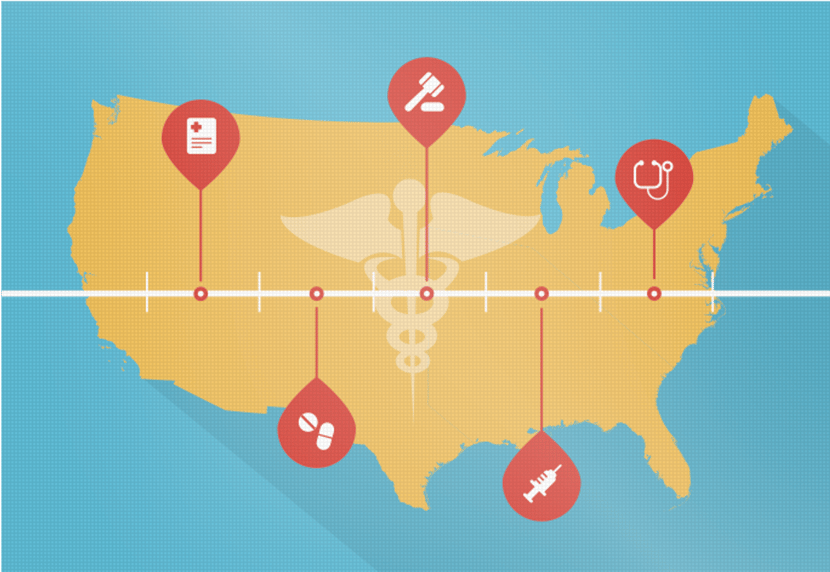 The American history of medicine and organized healthcare is quite a bit different than that of nigh other offset globe countries.
The American history of medicine and organized healthcare is quite a bit different than that of nigh other offset globe countries. The History of Medicine and Organized Healthcare: From the 1700's to Now
The 1700'due south: Colonial Times
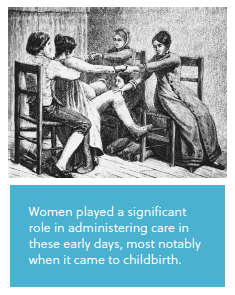 The outset medical guild was formed in Boston in 1735. Fifteen years later, in 1750, the beginning general infirmary was established in Philadelphia.
The outset medical guild was formed in Boston in 1735. Fifteen years later, in 1750, the beginning general infirmary was established in Philadelphia. The Mid 1800's: The Ceremonious War
The 1900's: The Industrial Revolution, Unions & Organized Healthcare
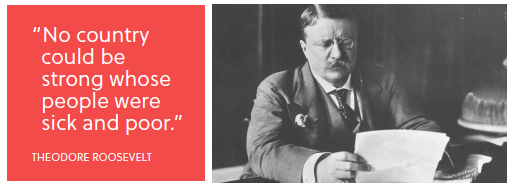
The 1910'due south - 1920's: WWI and Blueish Cross Blue Shield
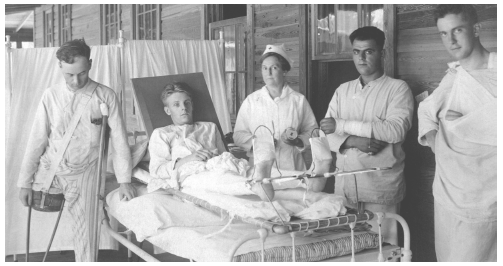 Wounded American WWI Veterans at the Base Hospital of Camp Joseph E Johnston, Florida CA 1918
Wounded American WWI Veterans at the Base Hospital of Camp Joseph E Johnston, Florida CA 1918 The 1930'south: The Great Low, Social Security & Henry Kaiser
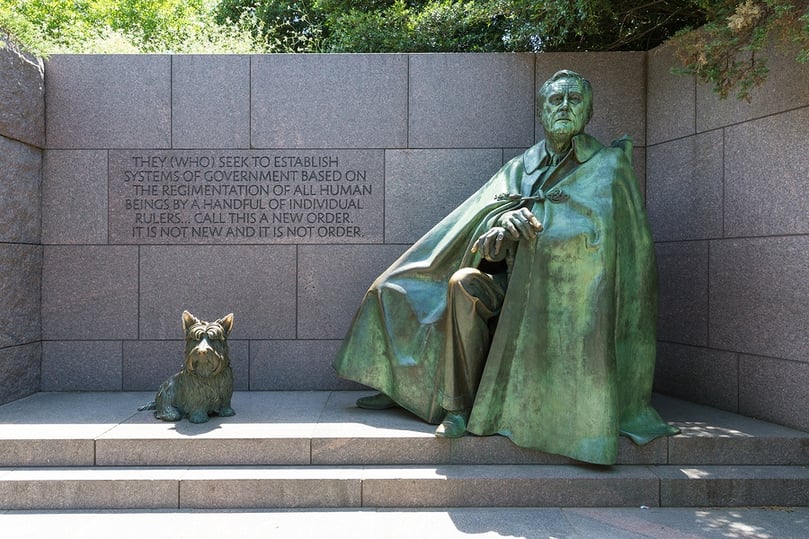
The Early on 1940's: World War Ii & Employer-Sponsored Healthcare
The Mid-to-Late 1940'south: Post Earth War II

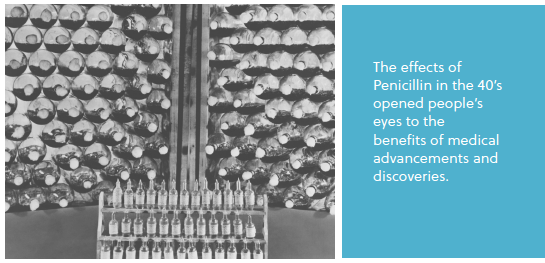
The 1950's: Medical Advancements & Costs
The 1960's: Social Security Expansion
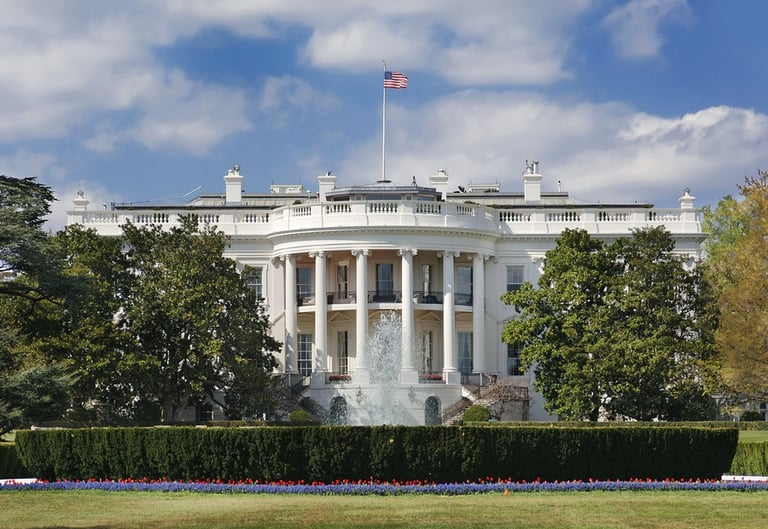
The 1970'due south: A Push for National Health Insurance

The 1980'southward: NHE Increases & COBRA
The 1990'due south: HIPAA & Medicaid Expansion
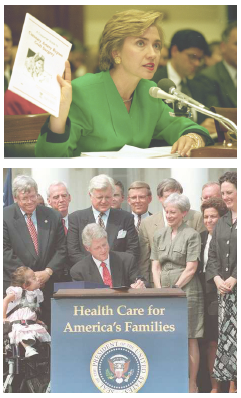 In 1996, Clinton signed the Wellness Insurance Portability and Accountability Human action (HIPAA), which established privacy standards for individuals. It also guaranteed that a person's medical records would be available upon their asking and placed restrictions on how pre-existing conditions were treated in grouping wellness plans.
In 1996, Clinton signed the Wellness Insurance Portability and Accountability Human action (HIPAA), which established privacy standards for individuals. It also guaranteed that a person's medical records would be available upon their asking and placed restrictions on how pre-existing conditions were treated in grouping wellness plans. The Early 2000's: Extending Coverage to Millions of Americans
2008 to 2016: The Affordable Care Act & Pre-existing Weather condition
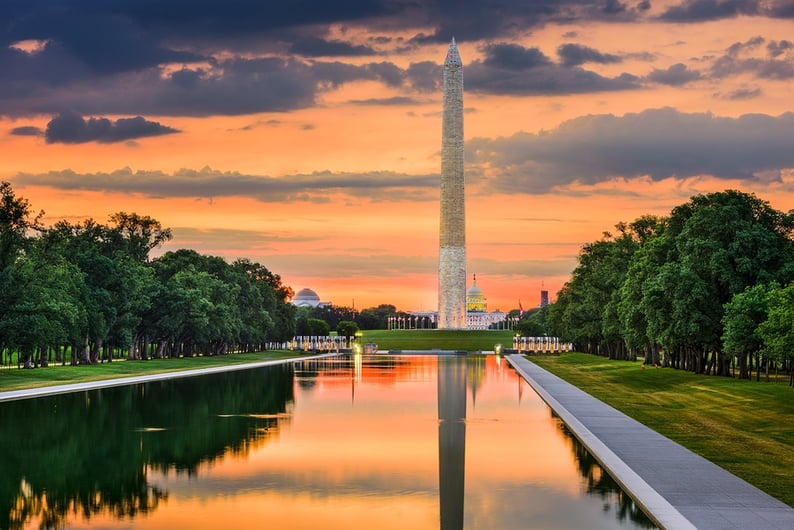
Nevertheless, viii million people signed up for insurance through the ACA Marketplace during the start open up enrollment season, with enrollment peaking in 2016 at 12.2 meg (with x meg of those receiving subsidies to help pay for insurance). 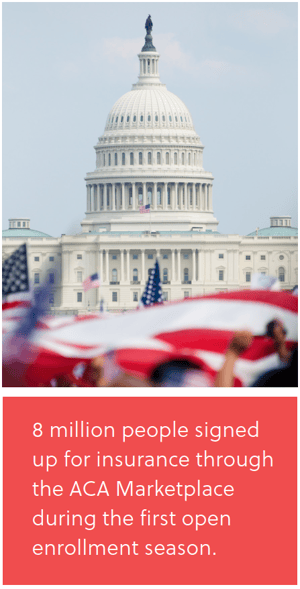
2017 to Present Mean solar day: The Trump Presidency
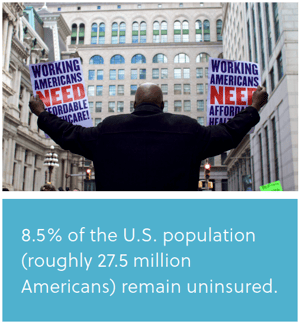
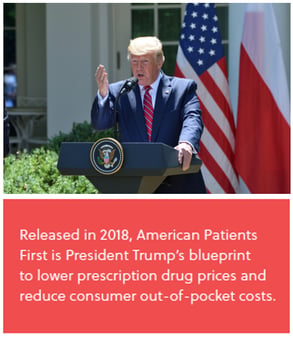 Despite these actions, the ACA has shown itself to exist fairly resilient. While some of the Trump administration's efforts have been caught up in the courts, and others simply haven't gone into outcome, some have been successfully implemented. Yet despite this, and the rising toll of insurance premiums, enrollment in the ACA has stayed relatively steady.
Despite these actions, the ACA has shown itself to exist fairly resilient. While some of the Trump administration's efforts have been caught up in the courts, and others simply haven't gone into outcome, some have been successfully implemented. Yet despite this, and the rising toll of insurance premiums, enrollment in the ACA has stayed relatively steady. The Future of Healthcare: The 2019/2020 Election Twelvemonth
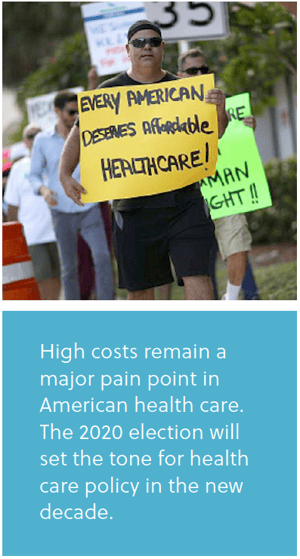 Merely a month later, in Dec of 2019, competing bills designed to reign-in prescription drug prices fabricated their style through Congress. Attempting to capitalize on President Trump's rather unorthodox public back up for government negotiation of drug prices (a 2016 campaign pledge), Speaker of the House Nancy Pelosi push through a firm beak in mid-December aimed at lower drug prices.
Merely a month later, in Dec of 2019, competing bills designed to reign-in prescription drug prices fabricated their style through Congress. Attempting to capitalize on President Trump's rather unorthodox public back up for government negotiation of drug prices (a 2016 campaign pledge), Speaker of the House Nancy Pelosi push through a firm beak in mid-December aimed at lower drug prices. In Closing

How The Role Of Physicians Has Changed Over Time In America,
Source: https://www.griffinbenefits.com/blog/history-of-healthcare
Posted by: namcoursocied1958.blogspot.com


0 Response to "How The Role Of Physicians Has Changed Over Time In America"
Post a Comment